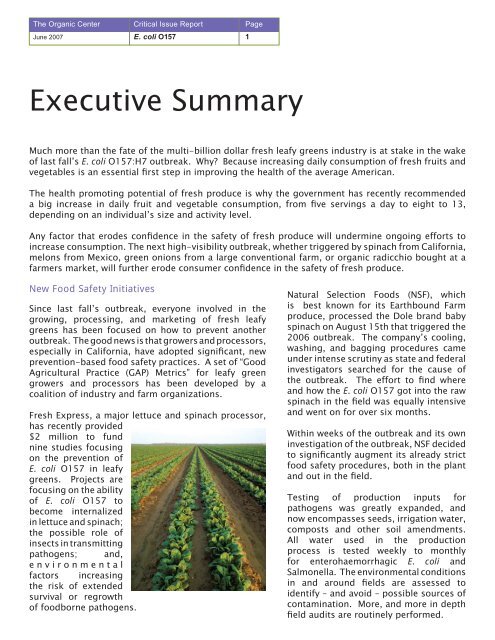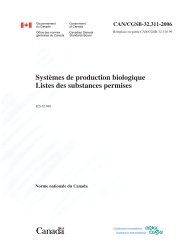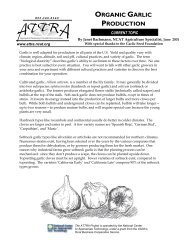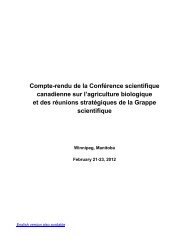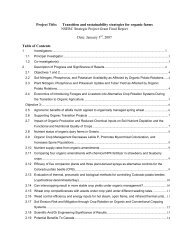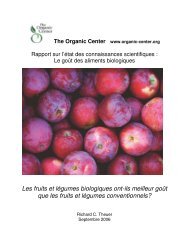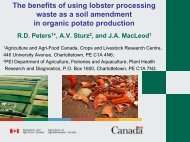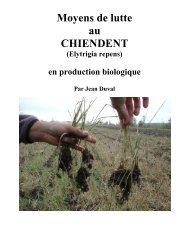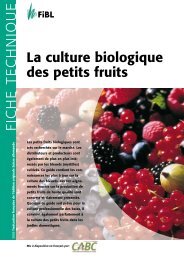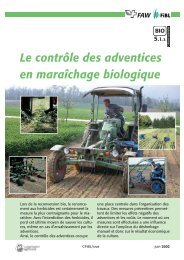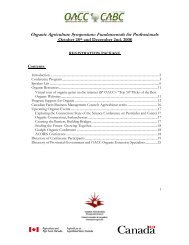Preventing E. Coli 0157 Outbreaks in Leafy Greens
Preventing E. Coli 0157 Outbreaks in Leafy Greens
Preventing E. Coli 0157 Outbreaks in Leafy Greens
You also want an ePaper? Increase the reach of your titles
YUMPU automatically turns print PDFs into web optimized ePapers that Google loves.
The Organic Center Critical Issue Report Page<br />
June 2007007 E. coli O157 1<br />
Executive Summary<br />
Much more than the fate of the multi-billion dollar fresh leafy greens <strong>in</strong>dustry is at stake <strong>in</strong> the wake<br />
of last fall’s E. coli O157:H7 outbreak. Why? Because <strong>in</strong>creas<strong>in</strong>g daily consumption of fresh fruits and<br />
vegetables is an essential first step <strong>in</strong> improv<strong>in</strong>g the health of the average American.<br />
The health promot<strong>in</strong>g potential of fresh produce is why the government has recently recommended<br />
a big <strong>in</strong>crease <strong>in</strong> daily fruit and vegetable consumption, from five serv<strong>in</strong>gs a day to eight to 13,<br />
depend<strong>in</strong>g on an <strong>in</strong>dividual’s size and activity level.<br />
Any factor that erodes confidence <strong>in</strong> the safety of fresh produce will underm<strong>in</strong>e ongo<strong>in</strong>g efforts to<br />
<strong>in</strong>crease consumption. The next high-visibility outbreak, whether triggered by sp<strong>in</strong>ach from California,<br />
melons from Mexico, green onions from a large conventional farm, or organic radicchio bought at a<br />
farmers market, will further erode consumer confidence <strong>in</strong> the safety of fresh produce.<br />
New Food Safety Initiatives<br />
S<strong>in</strong>ce last fall’s outbreak, everyone <strong>in</strong>volved <strong>in</strong> the<br />
grow<strong>in</strong>g, process<strong>in</strong>g, and market<strong>in</strong>g of fresh leafy<br />
greens has been focused on how to prevent another<br />
outbreak. The good news is that growers and processors,<br />
especially <strong>in</strong> California, have adopted significant, new<br />
prevention-based food safety practices. A set of “Good<br />
Agricultural Practice (GAP) Metrics” for leafy green<br />
growers and processors has been developed by a<br />
coalition of <strong>in</strong>dustry and farm organizations.<br />
Fresh Express, a major lettuce and sp<strong>in</strong>ach processor,<br />
has recently provided<br />
$2 million to fund<br />
n<strong>in</strong>e studies focus<strong>in</strong>g<br />
on the prevention of<br />
E. coli O157 <strong>in</strong> leafy<br />
greens. Projects are<br />
focus<strong>in</strong>g on the ability<br />
of E. coli O157 to<br />
become <strong>in</strong>ternalized<br />
<strong>in</strong> lettuce and sp<strong>in</strong>ach;<br />
the possible role of<br />
<strong>in</strong>sects <strong>in</strong> transmitt<strong>in</strong>g<br />
pathogens; and,<br />
environmental<br />
factors <strong>in</strong>creas<strong>in</strong>g<br />
the risk of extended<br />
survival or regrowth<br />
of foodborne pathogens.<br />
Natural Selection Foods (NSF), which<br />
is best known for its Earthbound Farm<br />
produce, processed the Dole brand baby<br />
sp<strong>in</strong>ach on August 15th that triggered the<br />
2006 outbreak. The company’s cool<strong>in</strong>g,<br />
wash<strong>in</strong>g, and bagg<strong>in</strong>g procedures came<br />
under <strong>in</strong>tense scrut<strong>in</strong>y as state and federal<br />
<strong>in</strong>vestigators searched for the cause of<br />
the outbreak. The effort to f<strong>in</strong>d where<br />
and how the E. coli O157 got <strong>in</strong>to the raw<br />
sp<strong>in</strong>ach <strong>in</strong> the field was equally <strong>in</strong>tensive<br />
and went on for over six months.<br />
With<strong>in</strong> weeks of the outbreak and its own<br />
<strong>in</strong>vestigation of the outbreak, NSF decided<br />
to significantly augment its already strict<br />
food safety procedures, both <strong>in</strong> the plant<br />
and out <strong>in</strong> the field.<br />
Test<strong>in</strong>g of production <strong>in</strong>puts for<br />
pathogens was greatly expanded, and<br />
now encompasses seeds, irrigation water,<br />
composts and other soil amendments.<br />
All water used <strong>in</strong> the production<br />
process is tested weekly to monthly<br />
for enterohaemorrhagic E. coli and<br />
Salmonella. The environmental conditions<br />
<strong>in</strong> and around fields are assessed to<br />
identify – and avoid – possible sources of<br />
contam<strong>in</strong>ation. More, and more <strong>in</strong> depth<br />
field audits are rout<strong>in</strong>ely performed.


